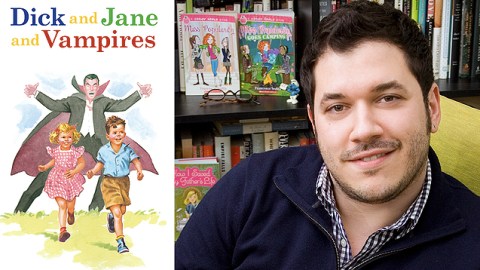Dick and Jane and Vampires: Francesco Sedita Gets Out of the Way

Grosset & Dunlap/Price Stern Sloan President and Publisher Francesco Sedita had a meeting with his entire team of editors, art directors and designers recently. The subject? A mustache.
“We’ve been slightly mustache-obsessed here at Grosset. I am currently sporting a mustache as are some of the other gentlemen.”
This is exactly the kind of topic that leads to the slam dunk, mass market books Sedita’s imprints are tasked with creating. Often targeted for reluctant readers, Sedita (an author himself) has helmed the creation of many projects designed to get kids to put down the remote and pick up a book.
Last year’s Dick and Jane and Vampires sprang from a discussion of mash-ups. TAG THIS! due out next summer features full-color photographs of sneakers, lockers and book bags ready for the reader’s graffiti. Frankly Frannie, a wildly popular middle grade series is about a little girl whose goal in life is to have a job in an office. The Frannie books feature a format that plays with fonts, illustrations and margin sizes—all aimed at making an easy reader have the heft of a book.
What’s the big idea? Sedita’s strategy to foster creativity among his team is two-fold:
1. Bring yourself to the work.
“A big thing in my career—for better of for worse—is that I’ve always tried to be myself in my job or in my writing,” says Sedita. “I feel like it’s all I have: the experiences that I bring to the table are mine. Those are the very things that make me worthy of being at the table. I try to foster that exact mentality here for all of the editors and the designers.”
While he admits that keeping an eye on accounting is part of the job, he’s less interested in cloning proven formats than he is about what excites the people he works with.
“Someone got inspired by a mustache that they saw,” Sedita says, “and now we’re all excited about how fun it would be to make a book about a mustache.”
2. Get out of the way.
“I’m less interested in my own ideas, and much more interested in hearing theirs,” says Sedita, who does his best to let his team’s process be about what they’re interested in.
“I’m doing editorial meetings in a very different way than we have before. I’m asking everyone to bring something to the table to show, whether it’s a manuscript—good or bad—an article in the Times, a web series they’re in love with; I’m asking three people per meeting to do a very short talk on a book that they’re reading from any genre, and tell us why they like it and why they don’t.
In addition, Sedita stresses the importance of helping the members of his staff get out of their own ways. Sometimes, it’s as simple as getting them out of the office. A couple of weeks ago his monthly creative meeting fell in the middle of No Meeting Week, something Sedita “really believes in.” Instead of having the meeting as scheduled, he bumped the start time to 4 p.m. and made everyone leave the building for the last hour of the day. He told them go for a run, or get coffee or a have a manicure.
“The ‘rules’ can and should be broken,” Sedita says. “If you don’t, the creativity gets stifled into fluorescent lights and brown carpet.”





